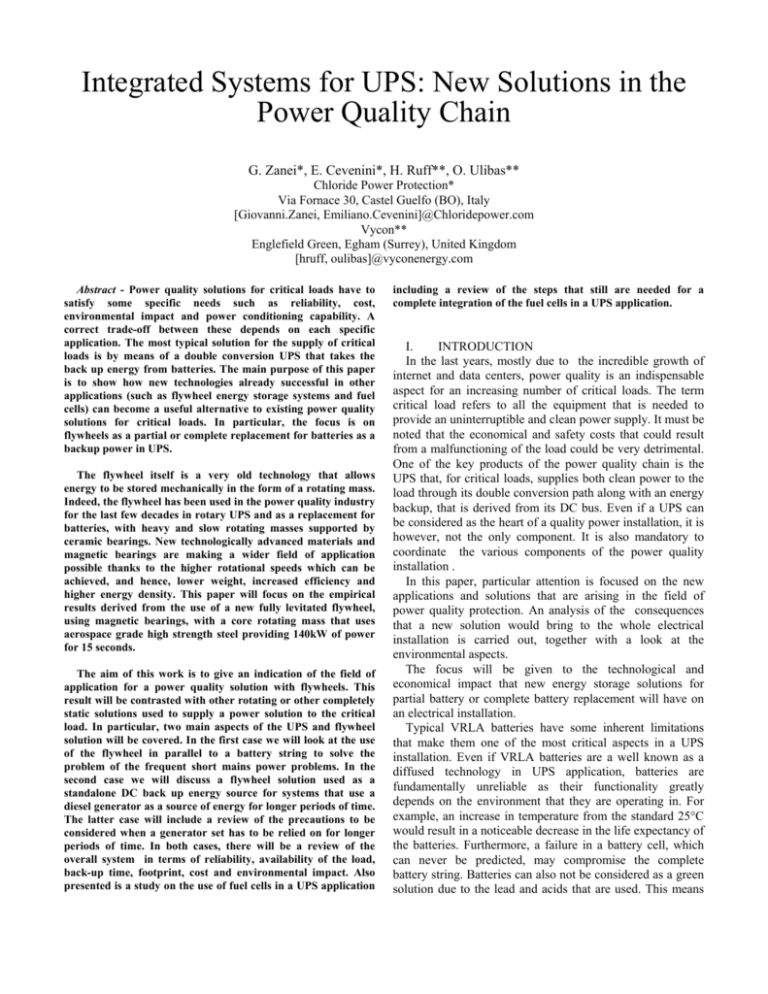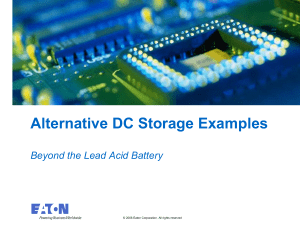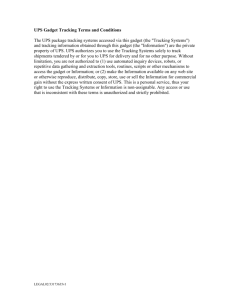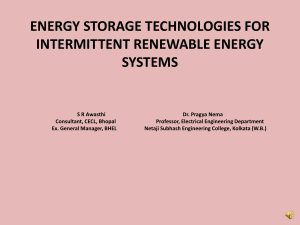Integrated Systems for UPS: New Solutions in the Power Quality Chain
advertisement

Integrated Systems for UPS: New Solutions in the Power Quality Chain G. Zanei*, E. Cevenini*, H. Ruff**, O. Ulibas** Chloride Power Protection* Via Fornace 30, Castel Guelfo (BO), Italy [Giovanni.Zanei, Emiliano.Cevenini]@Chloridepower.com Vycon** Englefield Green, Egham (Surrey), United Kingdom [hruff, oulibas]@vyconenergy.com Abstract - Power quality solutions for critical loads have to satisfy some specific needs such as reliability, cost, environmental impact and power conditioning capability. A correct trade-off between these depends on each specific application. The most typical solution for the supply of critical loads is by means of a double conversion UPS that takes the back up energy from batteries. The main purpose of this paper is to show how new technologies already successful in other applications (such as flywheel energy storage systems and fuel cells) can become a useful alternative to existing power quality solutions for critical loads. In particular, the focus is on flywheels as a partial or complete replacement for batteries as a backup power in UPS. The flywheel itself is a very old technology that allows energy to be stored mechanically in the form of a rotating mass. Indeed, the flywheel has been used in the power quality industry for the last few decades in rotary UPS and as a replacement for batteries, with heavy and slow rotating masses supported by ceramic bearings. New technologically advanced materials and magnetic bearings are making a wider field of application possible thanks to the higher rotational speeds which can be achieved, and hence, lower weight, increased efficiency and higher energy density. This paper will focus on the empirical results derived from the use of a new fully levitated flywheel, using magnetic bearings, with a core rotating mass that uses aerospace grade high strength steel providing 140kW of power for 15 seconds. The aim of this work is to give an indication of the field of application for a power quality solution with flywheels. This result will be contrasted with other rotating or other completely static solutions used to supply a power solution to the critical load. In particular, two main aspects of the UPS and flywheel solution will be covered. In the first case we will look at the use of the flywheel in parallel to a battery string to solve the problem of the frequent short mains power problems. In the second case we will discuss a flywheel solution used as a standalone DC back up energy source for systems that use a diesel generator as a source of energy for longer periods of time. The latter case will include a review of the precautions to be considered when a generator set has to be relied on for longer periods of time. In both cases, there will be a review of the overall system in terms of reliability, availability of the load, back-up time, footprint, cost and environmental impact. Also presented is a study on the use of fuel cells in a UPS application including a review of the steps that still are needed for a complete integration of the fuel cells in a UPS application. I. INTRODUCTION In the last years, mostly due to the incredible growth of internet and data centers, power quality is an indispensable aspect for an increasing number of critical loads. The term critical load refers to all the equipment that is needed to provide an uninterruptible and clean power supply. It must be noted that the economical and safety costs that could result from a malfunctioning of the load could be very detrimental. One of the key products of the power quality chain is the UPS that, for critical loads, supplies both clean power to the load through its double conversion path along with an energy backup, that is derived from its DC bus. Even if a UPS can be considered as the heart of a quality power installation, it is however, not the only component. It is also mandatory to coordinate the various components of the power quality installation . In this paper, particular attention is focused on the new applications and solutions that are arising in the field of power quality protection. An analysis of the consequences that a new solution would bring to the whole electrical installation is carried out, together with a look at the environmental aspects. The focus will be given to the technological and economical impact that new energy storage solutions for partial battery or complete battery replacement will have on an electrical installation. Typical VRLA batteries have some inherent limitations that make them one of the most critical aspects in a UPS installation. Even if VRLA batteries are a well known as a diffused technology in UPS application, batteries are fundamentally unreliable as their functionality greatly depends on the environment that they are operating in. For example, an increase in temperature from the standard 25°C would result in a noticeable decrease in the life expectancy of the batteries. Furthermore, a failure in a battery cell, which can never be predicted, may compromise the complete battery string. Batteries can also not be considered as a green solution due to the lead and acids that are used. This means that they must be treated as an hazardous material when they are disposed and therefore specific recycling procedures have to be considered. The increase in the price of Lead is also driving the continuous increase in the cost of batteries . All of these aspects mean that it is becoming ever more necessary to consider and understand other viable solutions as a replacement to batteries in UPS applications in order to be ready for future changes. A collaboration between Chloride Power Protection, manufacturer and distributor of UPS systems, and Vycon, a developer and manufacturer of magnetically levitated Flywheel Energy Storage Systems, studies the use of a flywheel as a backup energy storage on the DC bus of the UPS. Further on, in order to analyze other DC storage solutions for battery replacement, an initial understanding of the fuel cell technology linked with the UPS is given, underlining the pros, cons and the steps that need to be taken for its introduction. II. FLYWHEELS The Flywheel is a very old technology, that in recent times has been most commonly applied in internal combustion engines. A flywheel is also a simple form of mechanical energy storage. The Energy is stored by the rotor that spins around its axis. The amount of energy stored is proportional to the flywheel’s mass and to the square of its rotational speed: E ∝ Iω 2 (1) Where I is the momentum of inertia, that is directly proportional to the mass of the rotor by means of a constant that depends on the shape factor. For instance, the kinetic energy stored by an empty cylinder of mass M at a distance r from the rotational axes at an angular velocity of ω will be: E= 1 Mr 2ω 2 2 (2) Advances in power electronics, magnetic bearings and flywheel materials coupled with the innovative integration of components, have resulted in DC flywheel energy storage systems that can be used as a substitute or supplement to batteries in UPS systems. Additionally, the electronics in a Flywheel Energy Storage System allow continuous monitoring, and can indicate warnings and alarms to alert when action is needed. This is a major advantage over other DC Energy Storage sources used in the UPS today as in a UPS it is imperative to predict impending failures and prevent these failures from occurring. Although the flywheel system is generally more expensive than batteries in terms of the initial capital expenditure, aspects such as its longer life, simpler maintenance and smaller footprint for the same amount of power, make the flywheel system an attractive alternative to the battery. A. HIGH SPEED AND LOW SPEED FLYWHEELS Flywheel Energy Storage products can be macroscopically divided into two categories. Those that spin at >15.000 rpm (High Speed) and those that spin below 15.000 rpm (Low Speed). As stated previously, the energy stored is a function of speed. A flywheel with a higher speed will store more energy than another with the same mass but that operates at a lower speed (with the same mass). Composite materials tend to be operated at higher speeds compared to other materials such as steel. Both technologies have advantages and are used in the industry. The commercially available solutions with high rpm use a lighter mass compared to low rpm solutions with both composite materials and steel. These solutions are unique in that it is possible to use a controlled levitation mechanism that allows the elimination of any contact between the rotor and the stator. This therefore eliminates any friction. Even more, by eliminating the usage of mechanical bearings during normal functioning, it is possible to eliminate one of the main failure risks of the motor/generator and one of the most costly maintenance aspects of a flywheel. Hence, theoretically, this kind of solution gives a higher degree of reliability especially when a steel flywheel is used. This is due to the fact that a well designed steel rotor is designed to withstand several drops on the mechanical bearings that could happen due to magnetic bearing failure. In these occasions there is no need to replace the flywheel. On the other side, a composite material may break if it fell on to the mechanical bearings at full load. B. USE OF FLYWHEELS AS BATTERY HARDENING Flywheel energy storage devices have a relatively fast response time. A typical system can change from standby to discharge within 10 mS. This capability, when a flywheel is used in parallel with batteries (Fig. 1), can improve the life of a battery system. A typical system would discharge the flywheel at a level higher than where chemical discharge occurs on the batteries. This makes the flywheel the “first line of defense” against short power disturbances. This reduces the number of discharges on the batteries and hence prolongs the life of the battery system (“battery hardening”). This solution therefore improves the reliability of the system due to the lower stress level that is placed on the batteries. However, this solution does not solve the issue of failure predictability which a battery intrinsically has. Furthermore, ,it is difficult to examine the real benefit in terms of battery life C. USE OF FLYWHEELS AS COMPLETE BATTERY REPLACEMENT For emergency back-up systems that include UPS and generators, the flywheel energy storage system can be used as a complete replacement for batteries (Fig. 2). Power is available immediately, typically with an autonomy of tens of seconds. This means that the output of the UPS is not affected and therefore the load is also not affected. This can be seen in Fig. 3 where the DC Voltage, Output Voltage and flywheel current dynamics are measured during a mains failure. Current systems have enough ride-through time to allow for a transfer to a generator. For example, when there is a power disturbance, the UPS would operate in the backup mode using the Flywheel Energy Storage System as a DC source while a diesel generator is started. Today’s diesel generator technology can reach a stable operating speed and take load in as little as ten seconds. Therefore, a well maintained diesel generator, UPS and flywheel energy storage system can be an optimum emergency back-up system. However, this solution has the main weakness related to the reliability of the genset. Indeed, once the generator has started it will take 10 seconds to stabilize the output in order to take over the load. Therefore the issue is that of system start up reliability. For system startup several elements must be considered: batteries for the startup motor, available fuel for starting the engine and others. For this reason there are several steps that can be implemented to greatly increase the reliability of the startup. Such steps are, battery redundancy, heating of the coolant while on stand by and fuel positive pressure by means of specific pumping systems or positioning of the fuel tank above that of the motor level. In any case, a practical solution to increase the reliability is to regularly (e.g.: weekly) test the genset. AC DC UPS ATS AC DC DC AC Load Genset Flywheel Fig. 2 Complete battery free solution Fig. 3 UPS Output phase voltage, UPS DC bus voltage and DC output current from the flywheel. The output voltage doesn’t take any UPS Mains Power Supply Mains Power Supply DC AC Flywheel Fig. 1 Battery “hardening” solution Load Hence, a battery less UPS with a flywheel is a viable solution but attention has to be made to assure that the startup of the genset is reliable. In this case, the derived benefits from the use of this type of solution are: lower maintenance cost, the possibility of use in any typical environment and the predictability of failures due to the use of proactive monitoring systems. Several tests have been completed on the Chloride premises in order to test the functional capabilities of several flywheels from different producers, with the UPS. From the tests, where flywheels from Active Power, Pentadyne and Vycon, were used, it was seen that all of these work smoothly with Chloride’s UPS. Hence the choice of the correct solution to be used will remain on the specific overall performance of the flywheel. III. TRENDS IN DC ENERGY STORAGE FOR UPS: FUEL CELLS Apart from the flywheel solution discussed above, another really promising technology is the fuel cell. A fuel cell is a device that generates electricity by means of a chemical reaction between hydrogen and oxygen (see Fig. 4). This chemical reaction is completed inside the fuel cell that allows the electrons to separate from the Hydrogen ions which are then obliged to pass through the electrolyte. The electrons are then forced to follow an external electrical link. From Fig.4 it is possible to see that the chemical reaction which takes place in the anode (where a catalyst improves the reaction) is that of a separation of the Hydrogen molecules in ions and electrons: H 2 → 2 H + + 2e − (3) The ions are forced to flow through the electrolyte, while the electrons flow through an external circuit. When the ereaches the cathode, the following reaction takes place: Fig. 4 Basic functioning of a Fuel Cell + − O2 + 4 H + 4 e → 2 H 2 O (4) Hence, the result of the reaction is only water and energy in the form of heat. There are different fuel cell technologies that are mostly dependant on the material that is issued for the electrolytes and catalysts. Depending on these, there are then several possible working temperature ranges. The only commercially available fuel cell at a normal temperature range (its standard working range is between -50°C and +40°C) is the Polymer Electrolytic Membrane Fuel Cell (PEMFC). The main disadvantage of the PEM is that the output power can typically not reach more than 75kW of power. There are several other types of FC that are not yet commercialized that can operate at very high temperatures (even more then 1000°C) and can reach several hundreds of kW of output power. The Fields of application for these technologies are variegated, from vehicular to stationary application. UPS with fuel cells application have several advantages that make them a very interesting solution in this field: • FCs are environmentally friendly. The result of the reaction is only water and the fuel (Hydrogen) is non toxic, renewable and a clean to use solution. • Long backup time (virtually unlimited), depending on hydrogen availability. • Nominal performance over a wide temperature range (-40°C to 50°C). • Remote monitoring and control capabilities for each single cell. • Typically PEMFC have a predictable and reliable performance of about 10 years. On the other side there are some disadvantages that continue to make it difficult to successfully integrate the PEM fuel cells with UPS. These issues must be solved before successful integration can be permitted and these products can be commercialized within the UPS business. The main disadvantages are: • The fuel cell has a slow dynamic response. A 0 to 100% load step requires 60 sec to be supplied. During this time an alternative energy source must be used (batteries, ultra capacitors, flywheels …). • Fuel cell has a poor overload capability, typically not more than 10% for 60 secs. • Initial cost, if compared to batteries, is really high. • Fuel (Hydrogen) supply is not very easy. Normally the fuel is delivered by hydrogen cylinders (costly and limited). • Hydrogen cylinder usage is limited by their intrinsic explosion risk. Hence they must comply to severe regulations that limit their usage to outdoor areas or indoor areas that have special explosion proof cabinets. A. UPS AND FUEL CELL APPLICATION Chloride and Idatech, PEM stationary fuel cell producer, have jointly made an installation where a Chloride UPS uses an Idatech fuel cell as their typical application. In this paragraph we would like to summarize the installation characteristic and underline the main aspects that need to be followed in order to use a simpler and more commercial fuel cell solution together with a UPS. The installation has been made with a double conversion UPS that had to comply with the output voltage limits of a fuel cell of 48V. This was due to the most popular application for fuel cells being DC telecom applications. For this reason a 3kVA UPS had to be used, as it was the only one available with the necessary Vdc value. The fuel cell, that is installed with the UPS inside a data centre, takes Hydrogen from two cylinders situated externally (Fig.5). Despite the very long back up time, one of the main drawbacks is that the fuel cell has a slow dynamic response that needs to be compensated by a separate fast energy supply. Hence, Idatech uses a very small battery bank in parallel to the fuel cell stack. The energy supplied by the batteries will take over during the first seconds until the fuel cell is able to furnish all the necessary power. One important aspect to be noted is that of the actual voltage limit of the Idatech fuel cell, which is in fact 48Vdc. This limits its possible usages due to the fact that for powers of 5kW to 15kW (15kW is the maximum power for three fuel cells in parallel) the typical DC voltage of the UPS is higher than 48Vdc. This is certainly an issue since the use of an extra converter to boost the voltage can be deleterious in terms of efficiency. Hence, the installed application is made of 3kVA UPS that cannot benefit from the power capacity of the Idatech fuel cell. Fig. 5 Idatech 3kW Fuel Cell installation with a 3kVA Chloride UPS From the above point it is clear that some improvements are needed in order to widely integrate such promising technology for commercial use. To overcome the issue flywheels or supercaps can be used instead of batteries in order to give the short ride through that is necessary for the fuel cells takeover. In the future, higher power fuel cells could be more promising so that they can be used in critical applications, such as datacenters. In any case, the voltage limit of the cell must be able to cope with the increase in power. As previously stated, hydrogen supply is an issue, since the only means of hydrogen distribution is with high pressure cylinders. This indicates that special precautions have to be taken and these must be compliant to international and local standards. To avoid this problem a more efficient and more cost effective solution is to use a reformer that supplies H2 from a chemical reaction with other substances. Usually, as in the Idatech case, the reaction takes place in the reformer from a mix of methanol (CH3OH) and water (H2O): CH 3OH + H 2O → 3 H 2 + CO 2 (5) Hence CO2 is the only waste product. While using a Idatech fuel cell the cell autonomy using methanol is of 1kWh/litre. This potentially means that with a significantly lower space occupancy, lower risk reformer technology can be very useful. IV. CONCLUSION New technologies are arising with the aim of completely or partially replacing batteries as a DC energy storage in UPS. The technologies investigated are the ones that are the most promising in terms of commercially available solutions. The reasons behind the need for these new technologies are the continuous increment in cost of batteries, the hazardous materials present in the batteries, the ambient dependent characteristics and the fact that batteries do not have fault predictability. In this document the two most promising technologies are taken in consideration. Firstly, fully levitating flywheels, that allow a short ride through while a genset ramps up to give a virtually unlimited energy backup. Secondly, fuel cells, that by means of a completely green chemical reaction between hydrogen and oxygen also provide a virtually unlimited source of energy. On one hand, new flywheel technologies, such as the Vycon one, proved to be reliable , easily compatible with Chloride UPS and immediately available. On the other hand, fuel cell seems to be a very promising technology in UPS installations. It must be noted that the Fuel cell must cope with some limits, such as power availability and the connection to the DC bus of the UPS. Due to these it is currently only available for use in low power applications. REFERENCES [1] W.P. Turner, J.H. Seader, K.G.Brill “Tier Classification Define Site Infrastructure Performance”, The Uptime Institute Tier Performance Standards White Paper. [2] Federal Energy Management Program, “Flywheel Energy Storage”, Federal Energy Management Program [3] L L J Mahon, “Diesel Generator Handbook” Elsevier, 1992 [4] U. Bossel, B. Eliasson, “Energy and hydrogen economy”, 2003






